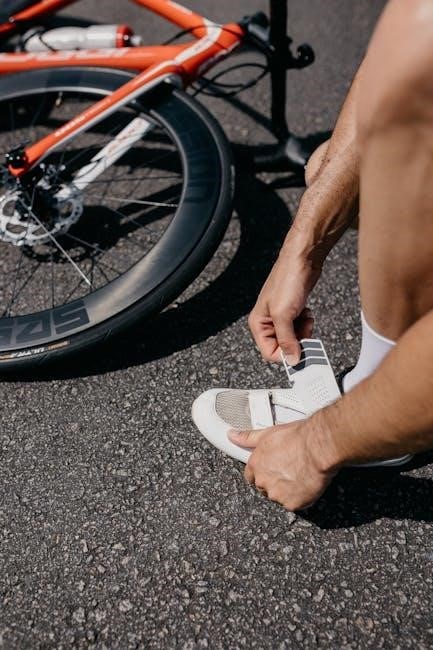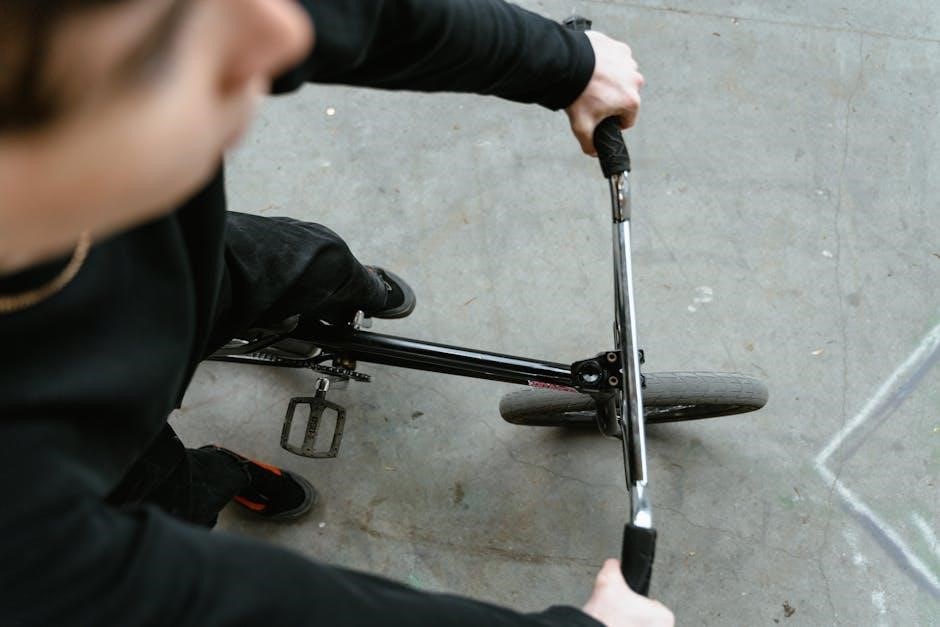The Ultimate Bike Shoe Size Guide
Discover how to find the perfect fit for your cycling shoes with expert tips on sizing, comfort, and performance. Ensure optimal pedaling efficiency and foot comfort.
- Use brand-specific size charts for accuracy.
- Measure feet at the end of the day for the best fit.
- Consider orthotics and riding style when selecting shoes.
A well-fitting shoe enhances your cycling experience and reduces discomfort during long rides.
Choosing the right bike shoe size is essential for comfort, performance, and overall cycling efficiency. A well-fitting shoe ensures proper power transfer, reduces discomfort, and prevents issues like numbness or pain during rides. With so many brands and styles available, finding the perfect fit can be challenging. This guide will help you navigate the process, from understanding sizing charts to considering factors like foot shape and riding style. Whether you’re a casual rider or a competitive cyclist, proper fit is key to enhancing your cycling experience. Avoid common mistakes like sizing down too much or ignoring shoe width. By following these expert tips, you’ll be able to select shoes that feel great and perform even better. Your feet—and your rides—will thank you.
Why Proper Bike Shoe Fit Matters
A proper bike shoe fit is crucial for both comfort and performance. Ill-fitting shoes can lead to discomfort, numbness, or even pain during rides, distracting you from your cycling experience. Shoes that are too tight can restrict blood flow, while those that are too loose may cause blisters or slippage. A snug fit ensures optimal power transfer with each pedal stroke, enhancing efficiency and reducing fatigue. Additionally, proper fit prevents issues like hotspots and discomfort, allowing you to focus on your ride. Investing in well-fitting shoes also supports long-term foot health, reducing the risk of chronic pain or injuries. Whether you’re a casual rider or a competitive cyclist, the right fit is essential for enjoying your time on the bike and performing at your best.

How to Determine Your Bike Shoe Size
Measure your foot length and width, use brand-specific size charts, and consider your riding style to find the perfect fit for optimal comfort and performance.
Understanding the Importance of Snug Fit
A snug fit is crucial for cycling shoes to ensure optimal performance and comfort. A shoe that is too loose can cause discomfort and inefficiency while pedaling, while one that is too tight can lead to pain and restricted movement. Cycling shoes should feel firm but not constricting, with enough room in the toe box to wiggle your toes slightly. This balance allows for proper blood flow and prevents numbness during long rides. A snug fit also enhances energy transfer to the pedals, improving overall efficiency. Additionally, it reduces the risk of blisters and hotspots, which can ruin your riding experience. Remember, cycling shoes are designed to fit tighter than casual shoes, so don’t be alarmed if they feel more restrictive initially. Proper fit ensures better support and control, making every ride more enjoyable and productive.

Using Bike Brand-Specific Size Charts
Each cycling shoe brand has its own sizing standards, so relying on brand-specific size charts is essential for an accurate fit. These charts account for variations in shoe lasts, materials, and intended use, ensuring a more precise match for your foot shape. When shopping, visit the brand’s official website to access their sizing guide. Compare your foot measurements to the chart, paying attention to both length and width. This approach helps avoid the common issue of sizing discrepancies between brands. Some brands even provide detailed fit matrices or size conversion tools to simplify the process. By using these resources, you can minimize the risk of ordering the wrong size and ensure a comfortable, performance-enhancing fit for your cycling adventures.
How to Measure Your Foot Length and Width
To determine your bike shoe size, accurately measuring your foot length and width is crucial. Start by placing a ruler on a flat surface and stand on a piece of paper, ensuring your weight is evenly distributed. Trace the outline of your foot carefully, marking the longest point for length and the widest point for width. Use a flexible measuring tape or a ruler to record these dimensions. For the most precise measurement, do this at the end of the day, as feet tend to swell slightly. Compare your measurements to the brand’s size chart, ensuring both length and width align with the recommended fit. This method helps you find a shoe that offers a snug yet comfortable fit, essential for optimal performance and comfort during rides.
Factors to Consider When Choosing Bike Shoes
Consider riding style, foot shape, and personal comfort to ensure the right fit and performance for your cycling needs.
Differences in Foot Shape and Shoe Fit
Foot shape plays a crucial role in determining the ideal bike shoe fit. Riders with narrower feet may prefer brands offering slimmer designs, while those with wider feet benefit from brands catering to broader widths. High arches or flat feet can influence the need for additional support or orthotics. Proper fit ensures optimal power transfer and comfort, preventing discomfort or injury. Brands like Shimano and Sidi offer varying widths, while others specialize in specific foot shapes. Testing shoes with cycling socks and orthotics ensures accuracy. A snug heel, roomy toe box, and supportive arch are key for performance and comfort during long rides.
How Orthotics and Insoles Affect Fit
Orthotics and insoles can significantly impact the fit of bike shoes, as they alter the internal space and support structure. These additions often require a larger shoe size to accommodate the extra material, ensuring comfort and proper alignment. Riders using custom orthotics should test shoes with their specific insoles to avoid tightness or pressure points. A snug fit around the heel and midfoot, combined with ample toe room, is essential for optimal performance. Overly tight shoes with orthotics can lead to discomfort or numbness, while too much room may reduce efficiency. When selecting bike shoes, consider brands that offer compatibility with orthotics or insoles. Trying shoes at the end of the day, when feet are largest, ensures the best fit. Proper alignment and support enhance both comfort and pedaling efficiency, making orthotics a valuable addition for many cyclists.
Choosing the Right Shoe for Your Riding Style
Selecting bike shoes tailored to your riding style ensures comfort and performance. Road cyclists benefit from stiff-soled shoes that maximize pedaling efficiency, while mountain bikers prefer more durable, flexible options for off-road traction. Indoor cycling shoes often feature breathable materials and secure closures for high-intensity workouts. Casual riders may opt for versatile shoes with a balance of stiffness and walking comfort. Consider the type of pedals and cleats compatible with your bike, as this impacts shoe choice. Ventilation, weight, and fit also vary based on riding intensity and terrain. Testing shoes during actual rides helps confirm the right style and fit for your specific needs. Aligning your shoe selection with your riding habits ensures a more enjoyable and efficient cycling experience. Always prioritize features that match your primary cycling activity to optimize both comfort and performance.

Common Mistakes to Avoid
Avoid sizing down too much, as this can cause discomfort and restrict toe movement. Not trying shoes on before buying often leads to poor fit. Ignoring shoe width can result in discomfort during rides; Always ensure proper fit to enhance performance and comfort.
Sizing Down Too Much
Sizing down too much is a common mistake when choosing bike shoes. While cycling shoes are designed to fit snugly, over-tightening can restrict toe movement and cause discomfort during rides. This can lead to numbness, blisters, or even long-term foot issues. Many riders assume that a tighter shoe improves performance, but excessive tightness can hinder pedaling efficiency and overall comfort.
To avoid this, ensure there is enough room in the toe box for slight movement. Use brand-specific size charts and try shoes on before purchasing. If unsure, consider consulting with a cycling expert or fitter to find the perfect balance between snugness and comfort. Proper fit is crucial for both performance and enjoyment on the bike.
Not Trying Shoes On Before Buying
Not trying shoes on before buying is a common oversight that can lead to poor fit and discomfort. Cycling shoes are designed to fit snugly, but everyone’s foot shape is different. Without trying them on, you risk purchasing shoes that are too tight or too loose, which can cause discomfort, blisters, or even affect your performance. Brand size charts are helpful, but they don’t account for individual foot shapes or personal comfort preferences.
- Foot width and shape can vary significantly between brands.
- A snug fit is crucial, but overly tight shoes can restrict movement.
- Trying shoes on ensures proper alignment with cleats and pedals.
Always visit a store to test shoes, especially if you’re new to cycling or unsure about sizing. A proper fit ensures comfort and efficiency during rides.
Ignoring Shoe Width
Ignoring shoe width is a mistake that can lead to discomfort and impaired performance. While many focus on length, width plays a crucial role in ensuring a proper fit. Cycling shoes come in various widths, from narrow to extra-wide, and failing to consider this can result in pinched toes or excessive movement; Narrow shoes can cause pain and numbness, while overly wide shoes may lack support.
- Check if brands offer different width options.
- Ensure toes have enough room without excessive space.
- Proper width ensures even pressure distribution.
A shoe that matches your foot’s width promotes comfort and stability, enhancing your cycling experience. Don’t overlook this critical factor when selecting your bike shoes.
Additional Tips for the Perfect Fit
Measure your feet at the end of the day for accuracy, as feet swell naturally. Troubleshoot poor fit by adjusting lacing or considering orthotics for optimal comfort and performance.

Measuring Your Feet at the End of the Day
Measuring your feet at the end of the day ensures accuracy, as feet naturally swell throughout the day. Use a Brannock device or trace your foot on paper to determine length and width. Wear the same type of socks you plan to use with your cycling shoes for an accurate fit. Stand upright and distribute your weight evenly when measuring. If one foot is larger, fit your shoes to the larger foot for comfort. This practice helps prevent discomfort and ensures optimal performance during rides.
- Use a ruler to measure the longest and widest points of your foot tracing.
- Compare measurements with brand-specific size charts for the best fit.
This simple step can make a significant difference in your cycling shoe comfort and efficiency.
How to Troubleshoot Poor Fit
If your bike shoes feel too tight or uncomfortable, check for proper sizing and alignment. Ensure the shoes are snug but not restrictive, allowing slight toe movement. If the heel slips, consider a smaller size or additional insoles. For width issues, look for brands offering wider options. Adjust lacing to distribute pressure evenly. If discomfort persists, consult a professional fitter or try a different brand. Proper fit is crucial for performance and comfort during rides.
- Check for adequate toe box space to prevent numbness.
- Experiment with orthotics or thicker socks if needed.
